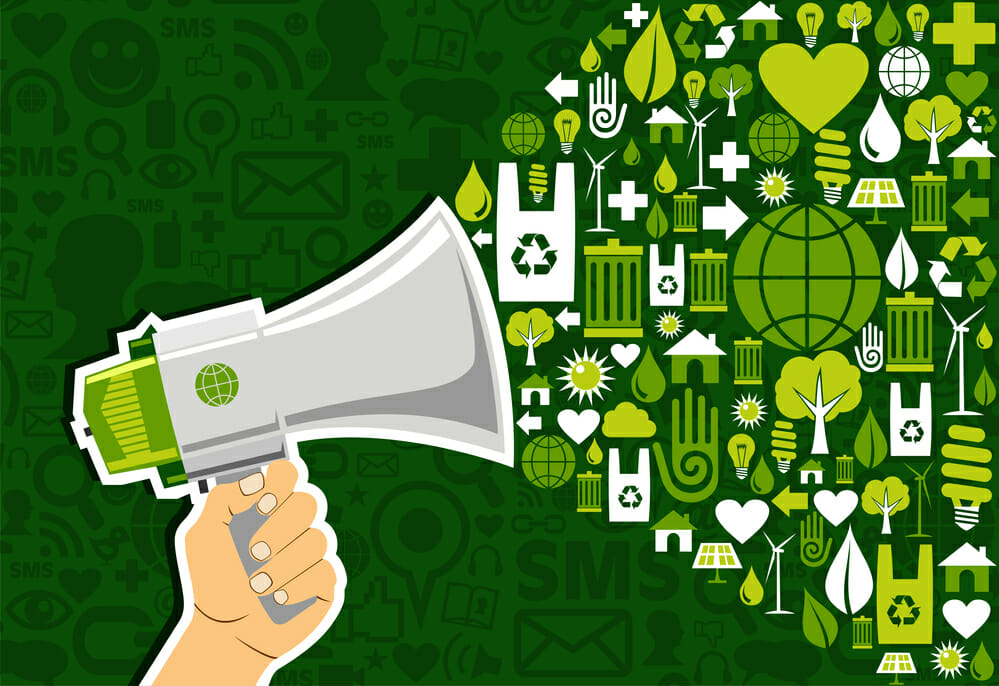In their book entitled Emerging Trends in International Business and Financial Services, Mahavir Sehrawet and Subhash Kundu note that packaging “plays the role of promotion of the product both by verbal and non-verbal communication.”
Consequently, businesses that want to show concern for the environment resort to green marketing by producing and promoting sustainable packaging, including shopping bags, paper bags and paper boxes.
However, introducing green marketing can present considerable challenges for companies accustomed to a certain way of doing things.
If you want to implement green marketing using packaging and other means, this article has all the information you need to set off on that path.
We define green marketing, follow its history, identify its benefits, and present some of its challenges. Finally, we provide some tips on using green marketing to promote your products.
Some Quick Green Marketing Statistics
Before we get into the gist of the matter, here are some statistics to give you a bird’s- eye view of the green marketing space:
- 45 percent of consumers surveyed by Statista.com indicated that they were interested in identifying environmentally responsible or sustainable brands.
- A study by Deloitte found that nearly 1 in 3 consumers claimed to have stopped purchasing certain brands or products because they had ethical or sustainability-related concerns about them.
- Simon-Kucher & Partners report that “Globally, 85 percent of people indicate that they have shifted their purchase behavior towards being more sustainable in the past five years.”
A 2017 study involving 1,000 Americans and cited by Forbes.com found that:
- 68 percent of millennials had purchased a product with an environmental or social benefit in the previous 12 months.
- 87 percent of consumers positively perceive an entity that supports an environmental or social cause.
- 88 percent will be more loyal to a business supporting environmental or social issues.
- 87 percent will purchase a product with an environmental or social benefit if given a chance.
What is Green Marketing?
There is no better place to find the definition of green marketing than Marketing-Schools.org. The website defines green marketing, which is sometimes called ‘eco-marketing’ or ‘environmental marketing,’ as “the marketing of products and companies that promote the environment in some substantial way.”
The New York-based financial media website Investopedia.com identifies some examples of green marketing, including advertising showing that a company has taken measures to reduce greenhouse emissions or uses post-consumer recycled material in packaging products.
The global employment website, Indeed.com notes that green marketing is a concept that belongs to a broader social movement toward more ethical and sustainable business practices.
The same source acknowledges that while green marketing alternatives may sometimes be more expensive, “they can often save money and drive a large increase in a company’s profits due to a newly identified market called Lifestyles of Health and Sustainability (LOHAS).”
The History of Green Marketing
The learning website, Study.com, traces the history of green marketing to the 1962 book by Rachel Carson entitled Silent Spring. The site reports that the book led to the US government banning the use of Dichlorodiphenyltrichloroethane (DDT), an insecticide, in 1972.
Study.com proposes that Carson’s book “created a snowball effect that eventually led to the change towards green marketing.”
Manisha Sahu writes for the Indian analytical content-writing company Analytic Steps. Sahu identifies an Ecological Marketing seminar held by the American Marketing Association in 1975 as the place where the green marketing concept was first presented.
Sahu adds that the term went mainstream in the late 1980s to the early 1990s when some prominent scholars started writing extensively about the concept.
Sahu reports that green marketing can be categorized into three phases:
- Ecological: where green marketing is characterized by attempts to resolve environmental problems.
- Environmental: involves focusing on clean technologies and conceptualizing innovative products that reduce waste and pollution.
- Sustainability: is triggered by the realization that today’s needs should be met in a way that does not jeopardize the survival of future generations.
The Benefits of Green Marketing

If green marketing requires organizations to change the way they do business, potentially increasing costs, why do organizations perceive it as a viable strategy? It presents certain benefits that entities realize will be beneficial in the long run.
Here are some benefits that organizations can gain from green marketing:
Catering for a Market That is Aware
It is rapidly becoming apparent to consumers that the way we have treated the earth and its resources is not sustainable. Voices calling for sustainable development and green practices from nonprofit organizations like Greenpeace, Earth Justice, and the World Wildlife Fund have grown even louder in the last few years.
These voices have led to consumers being more aware of green issues, and green marketing provides organizations with an opportunity to show their dedication to such matters.
Helps the Environment
Even though marketing, in general, is about increasing a company’s profit, green marketing goes further than that. It represents a recognition that the environment is a crucial source of the raw materials and customers that are required by the business to sustain itself into the future.
Therefore, one of the main benefits of green marketing is that it sustains the environment that allows businesses to continue making profits.
Cost-Effective
Green marketing leads to environmentally friendly products and processes. Your green marketing initiatives will need you to show that you save energy and try to lower your carbon footprint by finding more efficient ways of doing business. This helps you save resources and money.
For example, when you give your customers kraft paper bags for their shopping, they can use them several times before they need new ones. This could reduce the amount of space you need to keep bags on your premises, and it reduces the transport costs required to continuously supply single-use plastic.
Challenges of Green Marketing

It’s vital to acknowledge that companies deciding to use green marketing will face challenges. This is because attempting to do things in a way that deviates from the traditional is hardly a walk in the park.
Knowing the challenges you may face when implementing green marketing will ensure that you create strategies for dealing with them.
Indeed.com identifies two main challenges that can be faced by organizations when they implement green marketing:
Greenwashing
Attempts to use green marketing can easily blow up in your face if you do it halfheartedly. This is because many companies pretend to follow environmentally friendly practices when they are doing the opposite. This is called greenwashing.
Indeed.com provides a typical example that companies use when greenwashing: claiming that their products are “organic” when they are not.
Time and Cost
Establishments attempting to go green need to be prepared for the initial costs of developing a green marketing strategy.
For example, an organization wanting to make green claims will need to be properly audited and accredited by an official body. To get these certifications, you will need to put in a lot of time and work, which will gobble up a substantial amount of money and time.
Implementing Green Marketing

The telecommunications company Verizon suggests five strategies you can use to implement your green marketing campaigns.
Create Greener Products
To create greener products, you will need to ensure that your raw materials are environmentally friendly and responsibly sourced.
Verizon gives the example of footwear, apparel, and equipment-maker Nike, which “has a long list of sustainability strategies, from dye water recovery to a move towards a zero-waste manufacturing system – their products are made from 75% recycled materials.”
Support Environmental Initiatives
Verizon suggests some practical ways of supporting environmental initiatives:
- Donate to environmental causes.
- Use local raw materials to reduce distances traveled.
- Create a clear environmental goal and tell everyone about it.
- Incorporate green practices in all aspects of your organization.
- Implement a plastic-free workplace lunch policy.
Choose Sustainable Packaging
Reducing waste means coming up with measures that encourage one item to be used several times. For your green marketing efforts to be effective, you will need to eliminate single-use plastic in your organization.
If you are going to get rid of plastic, ensure that you give consumers a greener alternative for shopping bags and other plastic products.
Reduce Waste and Recycle
The initial idea is to reduce waste as much as possible. You can’t be talking green marketing if your pavement lights are on 24/7 or water is leaking from your pipes into the pavement.
Because waste will inevitably be created in any process, try to recycle as much waste as possible. If you can’t recycle the waste, you must dispose of it in an environmentally friendly way.
Participate in Green Campaigns
Identify areas where your customers go and the causes they support and participate in them. For instance, your company can offer cleaning services during a marathon and ensure that all the plastic used is gathered and taken to a recycling facility.
Make Going Green a Way of Life
The idea of green marketing emanates from the realization that there is a link between economic stability and the environment’s well-being. Therefore, it is not something you should do because you feel forced to do so, but instead, because you are convinced that this is the right thing to do.



